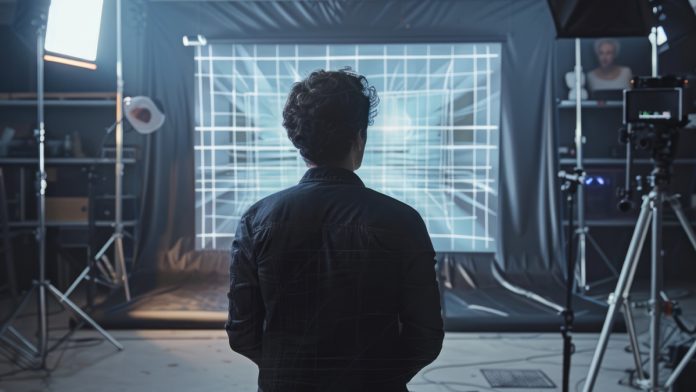Modern filmmaking increasingly relies on LED walls and real-time rendering to blend live action with virtual environments seamlessly. In this article, Inside the Virtual Set: LED Walls and Real-Time Rendering in Modern Filmmaking, we unpack the technical pillars that make these immersive stages possible. From calibrating panels for accurate color to harnessing AI-driven scene augmentation, each element plays a vital role in creating believable virtual worlds. Either you are a cinematographer, technical director, or enthusiast, understanding these innovations will illuminate how digital and physical realms unite on set.
| Table of Contents | |
|---|---|
| I. | High-Fidelity LED Panel Calibration and Color Matching |
| II. | Precision Camera Tracking and Sensor Fusion |
| III. | Real-Time Engine Optimization for Ultra-Low Latency |
| IV. | Dynamic Parallax Correction and Perspective Stitching |
| V. | HDRI Environment Mapping and Wide Gamut Lighting |
| VI. | On-Set Color Pipeline and Live LUT Management |
| VII. | Scalable Network Infrastructure for Data Streaming |
| VIII. | Virtual Asset Management and Version Control |
| IX. | Multi-Camera Synchronization and Composite Delivery |
| X. | Volumetric Capture Integration and Depth Blending |
| XI. | AI-Driven Scene Augmentation and Automated Feedback |
High-Fidelity LED Panel Calibration and Color Matching
Accurate calibration ensures each LED panel in a volume matches its neighbors, producing uniform brightness and color fidelity across the entire display. Technicians use spectroradiometers and waveform monitors to measure gamma curves and color gamut, aligning panels to a common reference. Proper color matching eliminates visible seams and ensures virtual backgrounds render consistently with on-set lighting. This process underpins the illusion of a single coherent environment, allowing actors to interact naturally with dynamic digital scenery without post-production color correction.
Precision Camera Tracking and Sensor Fusion
Real-time camera tracking combines optical markers, inertial measurement units (IMUs), and sensor fusion algorithms to capture precise position, orientation, and lens metadata. This synchronicity allows the virtual background to update seamlessly with each camera move. Accurate tracking is critical: when integrated with LED walls, the rendered scene shifts correctly, maintaining perspective. Inside the Virtual Set: LED Walls and Real-Time Rendering in Modern Filmmaking relies on this fusion to prevent parallax errors and ensure digital elements stay locked to physical camera movements, preserving immersion for both crew and talent.
Real-Time Engine Optimization for Ultra-Low Latency
Reducing latency between camera motion and display updates is essential to avoid distracting lag. Developers optimize real-time engines by streamlining shader complexity, using level-of-detail (LOD) streaming, and prioritizing critical assets in memory. GPU pipelines are tuned to minimize draw calls and ensure frame rates exceed the 48–60 FPS threshold. By fine-tuning render queues and leveraging hardware-accelerated codecs, productions achieve sub-20-millisecond latency. This responsiveness allows directors to preview fully composited shots live, accelerating creative decisions and reducing reliance on costly post-rendering workflows.
Dynamic Parallax Correction and Perspective Stitching
Dynamic parallax correction adjusts content on LED walls to match camera-specific viewpoints, eliminating the flatness that can betray a virtual set. Advanced perspective stitching algorithms mesh multiple panel outputs, accounting for lens distortion and multi-projection overlaps. This creates seamless visuals from varied camera angles. Inside the Virtual Set: LED Walls and Real-Time Rendering in Modern Filmmaking benefits from these techniques by ensuring each shot maintains correct depth cues, so actors perceive consistent backgrounds even when the camera moves laterally or changes focal length.
HDRI Environment Mapping and Wide Gamut Lighting
HDRI environment mapping uses high-dynamic-range images captured on location to recreate realistic sky and ambient lighting within the virtual set. Artists sample 360° captures, then adjust exposure and color temperature to match on-set fixtures. Wide gamut LED panels reproduce nuanced highlights and deep shadows, mimicking natural light transitions. This technique ensures that reflective surfaces, from metallic props to water, respond authentically to lighting conditions. The result is a cohesive composite where virtual and physical elements share a convincing visual tone, enhancing believability.
On-Set Color Pipeline and Live LUT Management
Managing color in-camera involves applying live Look-Up Tables (LUTs) directly in the real-time engine, ensuring the LED wall output matches the production’s final grading intent. Dailies operators adjust LUTs on the fly to compensate for scene changes, guiding directors with near-final imagery. Inside the Virtual Set: LED Walls and Real-Time Rendering in Modern Filmmaking leverages these live pipelines to maintain consistency across takes, reducing post-production time. By integrating color management tools into the virtual set, productions guarantee that every frame aligns with the director’s color vision from shoot to edit.
Scalable Network Infrastructure for Data Streaming
A robust network is vital for streaming high-resolution textures, 3D models, and camera metadata between servers, rendering nodes, and control stations. Productions deploy 10/25/40 Gigabit Ethernet, with redundant links and low-latency switches, to handle constant data flow. Edge servers cache assets near the volume, reducing transfer times for dynamic scene updates. Quality-of-service (QoS) protocols prioritize real-time rendering traffic, preventing interruptions. This scalable infrastructure supports multi-user workflows, enabling lighting, camera, and VFX teams to collaborate live without bottlenecks.
Virtual Asset Management and Version Control
Effective asset management tracks changes across textures, models, and scene graphs, ensuring the correct versions feed into the LED volume. Version control systems like Git LFS or Perforce integrate with real-time engines, automatically syncing updates to render nodes. Inside the Virtual Set: LED Walls and Real-Time Rendering in Modern Filmmaking depends on this synchronization to avoid mismatches that could break continuity. Metadata-driven pipelines log commit histories and author details, enabling rollbacks and audit trails, which is essential for complex productions with multiple artists contributing concurrently.
Multi-Camera Synchronization and Composite Delivery
Shooting with multiple cameras demands synchronized output across each LED wall section, so every viewpoint receives the correct composite. Timecode generators lock camera, audio, and rendering systems to a shared clock. Clustered compute nodes divide scenes into tiles for each camera angle, then recombine them in post or deliver live composites. By coordinating these pipelines, productions capture cutaways and wide shots simultaneously without losing alignment, streamlining multi-camera coverage for interviews, live events, and narrative scenes.
Volumetric Capture Integration and Depth Blending
Combining volumetric capture with LED volumes allows for three-dimensional performances to appear within the virtual stage. Point-cloud data from depth sensors merges with synthetic backgrounds, then blends edges using alpha matting. Inside the Virtual Set: LED Walls and Real-Time Rendering in Modern Filmmaking harnesses depth blending to integrate holographic talent or creatures with accurate occlusion. Real-time compositing ensures physical props and volumetric actors interact seamlessly, opening creative possibilities for immersive narratives and interactive media experiences.
AI-Driven Scene Augmentation and Automated Feedback
Artificial intelligence accelerates virtual set production by generating background assets, automating camera-motion predictions, and providing real-time quality analysis. Machine learning models refine textures, fill occlusion gaps, and optimize lighting presets based on shot parameters. Automated feedback tools alert operators to tracking errors or rendering artifacts, allowing immediate correction. This AI-driven augmentation reduces manual workloads and enhances creative freedom, empowering filmmakers to iterate on complex scenes faster while maintaining high production standards.

